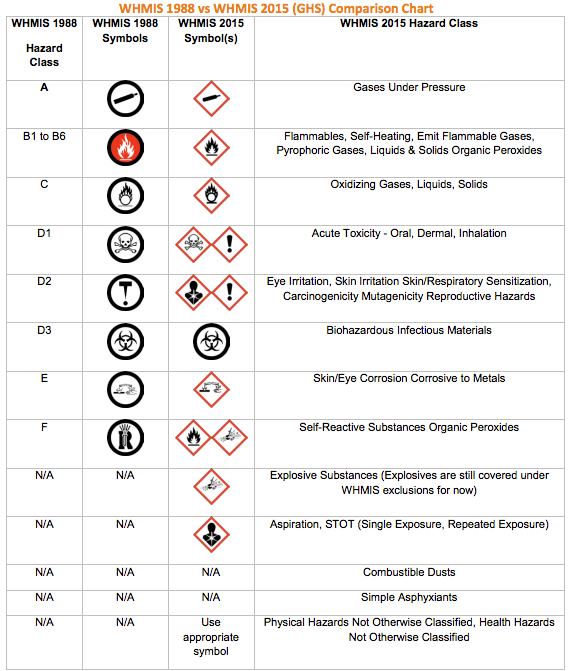At some point in your life, you’ve probably heard of WHMIS hazard symbols, whether it be for workplace safety training or for a class in school. It may have felt daunting to learn 9 distinct symbols related to chemicals you occasionally encounter, but the recognition and knowledge of these WHMIS symbols, continues to be a necessity for employers to ensure safety standards are met in the Canadian workplace.
The introduction of WHMIS 2015 includes revisions to the WHMIS symbols, we have worked hard to familiarize ourselves with; luckily the images representing each hazard have not entirely changed. WHMIS symbols are now contained within a square sitting on one of its points instead of a circle, the border colour is red instead of black, and the symbols themselves are also black. Other distinct changes involve the hazard classes being represented by these symbols or the addition of new symbols including ‘exploding bomb’, ‘health’ and ‘environmental’ (not required in Canada) symbols. The ‘Biohazardous and Infectious Materials’ symbol has not changed from WHMIS 1988. The WHMIS symbols comparison chart below describes the differences.

To comply with the new changes given to WHMIS symbols companies and businesses should keep these things in mind:
- WHMIS 2015 refers to the use of symbols as pictograms: a graphical composition with graphical elements such as specific symbols, borders, and colouring
- Hazardous products that affect the health of an individual are classified under the health hazard group and depicted by a black, shaded-in, human figure with a white, star-design located on the chest. Its combination with the exclamation mark symbol indicates that hazardous products were placed in the less severe sub-categories for specific health hazards
- Division 1 (D1) of ‘Poisonous and Infectious Materials’ for hazardous products that cause immediate death or acute toxicity (oral, dermal, or inhalation), retains the skull and bones depiction seen in WHMIS 1988
- The T symbol representing ‘Materials Causing Other Toxic Effects’ in Division 2 (D2) of the ‘Poisonous and Infectious Materials’ has been removed. The exclamation symbol now represents less-severe acute toxicity hazards (oral, dermal, or inhalation)
- The dangerously reactive ‘R symbol’ has been removed and and is now depicted by a flame symbol, explosion symbol or a combination of both these WHMIS symbols; these symbols are used to identify products classified into the self-reactive or organic peroxide hazard classes.
- Where the skull and bones symbol is used to depict hazardous products that cause toxicity, one can assume the hazard risk is severe, and acute (small concentrations can cause consequential health effects). The exclamation symbol should not be used anywhere the skull symbol is used.
- The corrosion symbol (represented by two-hands) indicates corrosive hazards of greater severity, and thus an exclamation symbol is not to be used in-conjunction with it, for highly corrosive materials.
Portrayal of the hazards classes and categories using the pictogram system may seem confusing at first and it could take a little while to get used! Both employers and employees should familiarize themselves with how these symbols relate to the GHS-standardized classification method prior to the completion of the WHIMIS 2015 transition. Ultimately, the GHS pictogram modification to WHMIS symbols further constitutes Canada’s efforts in regulating chemical products on a more global-scale, reducing costs for both in-house and foreign suppliers and users of these hazardous products.
We’re WHMIS Experts
For quality compliance resources for companies of all sizes across the world.
